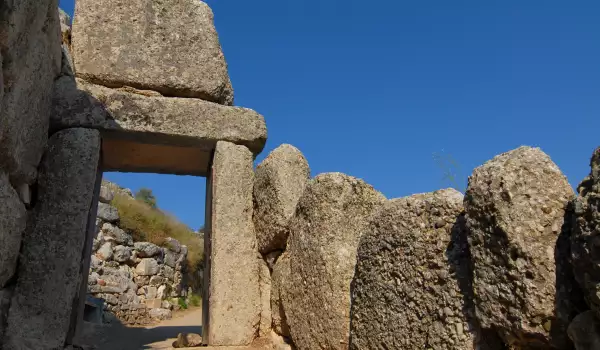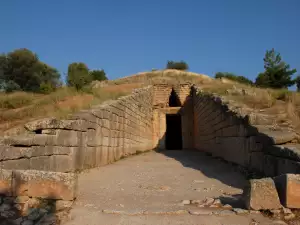Mycenae

Mycenae (Mykene) is the capital of a legendary kingdom of Mycenaean Greek history. Today Mycenae is an archaeological town in Greece, located about 90 km. southwest of Athens, northeast of the Peloponnese. The citadel built of stone, is the legendary city of Agamemnon, and the Mycenaean civilization flourished during the Bronze Age. Since 1999 the ruins of Mycenae are included in the list of World Heritage Sites by UNESCO.
Indeed Mycenaean kingdom was the first Greek civilization Minoan Crete replacement. It dominated by military power around 400 years, over much of southern Greece. Territories of Mycenae extended to the eastern Mediterranean. Real Mycenaean civilization is one that lays the foundation of classical Greek culture and set the course of its development. That is why the period from about 1600 BC to 1100 BC be called Mycenaean period.
Mycenae was discovered in 1866 by Heinrich Schliemann, who carried out excavations, building on Omir. He found in Mycenae a huge amount of gold. In 1939, the American scientist Charles Bletchan’s documentary opens Pylos. In 1950 Englishman Allen Wain and his associates finish excavating Mycenae.
As a result, all excavations found several tablets of unknown script and language. Michael Ventris was one who deciphered the text, based on conservative dialect - Arcadian-Cyprian. He deciphers the known 65, then 90 characters.
After his death, in 1955 his work was continued and published by Chedrik. Since then, to this day we are discovering and deciphering the ever new symbols and translating the texts of the tables.
In Mycenae were found fragments of pottery dating back to 3500 BC, the time of the Neolithic, remains from the period 2100 BC to 1700 BC, the Early Bronze Age. From the Middle Bronze Age (1800 - 1700 BC) were dated the first discovered graves and burial pits. Discovered by Schliemann, shaft tombs from the so-called circle The cemeteries, which total 6 in number, are very rich in luxury items and date from the 16 century BC. All socio-economic life in Mycenae was subject to war.

Abundance and luxury is solely due to the spoils of war, or piracy. All this leads to domination of Mycenae over the entire Aegean world. Acropolis in Mycenae has a clear triangular shape. In the foreground on the left is the main entrance.
Lion door with a massive wall- Above it there are two lions, symbols of the goddess, protector of the city. If a man climbed over the royal fortress, to see how impregnable it was thousands of years ago. Acropolis or "high city" of Mycenae was created in the early 15 th century BC and about 1350 BC it and the surrounding walls are restored to "Cyclops” style.
According to legend, the works were made by the Cyclopes, because of the large size of the rocks from which they are built. Perhaps the most interesting in Mycenae remains the alleged tomb of King Agamemnon. It is located next to the citadel - an impressive stone building with a height of almost 15 meters.
The two largest cities of the Mycenaean kingdom are Mycenae and Tiryns. They are celebrated and immortalized in epics of Omir - Iliad and Odyssey, and the very Mycenae described as the kingdom of Agamemnon.
Today, most people come to see the ruins of Mycenae for one reason - to touch the place where he began a legendary and epic war in the name of a woman – Helen of Troy.









